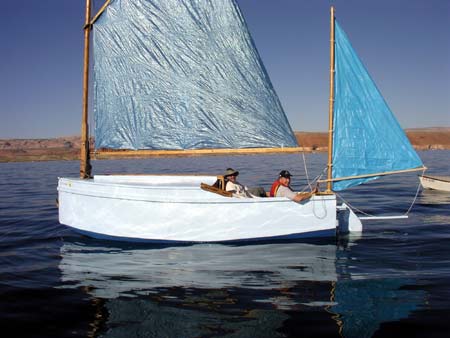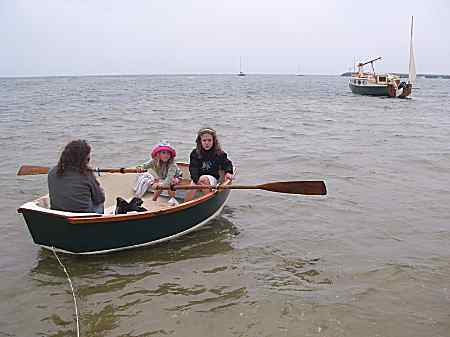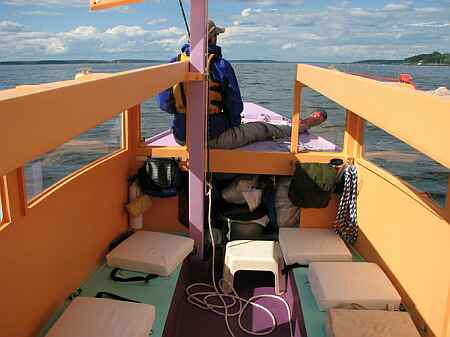
Ted Kilsdonk and company go for an Oracle row in New Jersey.
Contents:
Contact info:
Jim Michalak
118 E Randall,
Lebanon, IL 62254Send $1 for info on 20 boats.
Jim Michalak's Boat Designs
118 E Randall, Lebanon, IL 62254
A page of boat designs and essays.
(1Dec08)This issue will take a look at what happens when the weight goes up. The 15 December issue will rerun the capsize issue.
THE BOOK IS OUT!
BOATBUILDING FOR BEGINNERS (AND BEYOND)
is out now, written by me and edited by Garth Battista of Breakaway Books. You might find it at your bookstore. If not check it out at the....ON LINE CATALOG OF MY PLANS...
...which can now be found at Duckworks Magazine. You order with a shopping cart set up and pay with credit cards or by Paypal. Then Duckworks sends me an email about the order and then I send the plans right from me to you.

|
Left:
Ted Kilsdonk and company go for an Oracle row in New Jersey.
|
|
|
Weight Problems
WEIGHT HAS A BIG EFFECT....
...on how your boat will go. Here is an example with will use my AF2 design from a few years back. Here is a photo of Richard Spelling's AF2 (the only one I know of to get built):

And here is a line drawing:

AF2 is a rather typical sharpie, 20' long and 5' wide on the bottom with a single gaff sail. The cuddy cabin is roomy enough for a solo bed room and it has a slot top that could be left open for sailing on nicer days.
One of my design guesses was that it would have an empty weight of 600 pounds and I'll tell you how I stab at that. AF2 requires, no guesses here, six sheets of 1/4" plywood, seven sheets of 3/8" ply, and one sheet of 1/2" ply by the blueprint. The usual plywood weighs about 25 pounds for a 1/4" sheet, about 38 pounds for a 3/8" sheet, and about 50 pounds for a 1/2" sheet. The resulting pile of plywood should weigh about 470 pounds and I have found that to be a good guess at the weight of such a hull bare with no extras. Add maybe 50 pounds for the sail rig. Then round up and there I am at 600 pounds.
Now that is a minimum weight boat in the water. Add a skipper and some of his junk and let's say the boat is sailing at 1000 pounds most of the time. Using our old friend Hullform we would expect a waterline like this:

It looks quite good to me and I have been taught to look at it with Phil Bolger's eyes. He said sharpies need to sail over the water and not through it. The bow is swept well above the water to meet the waves with the bottom and not pushing through them with the sides. The stern is also well out. She would have a short waterline bolt upright as in light winds, minimum wetted surface area so they say. But a sailing breeze would heel her over to get a longer waterline when there is power in the wind. And heeled she would meet the waves with the edge of her chine like a V bottomed boat. It all works great provided the conditions are right. The best case is a strong wind with smooth water. The worst case is rough water and little wind. So sharpies have split personalitites much more so than V bottomed or round bottomed boats.
I might add that the short upright waterline helps a lot for quick maneuvering.
Now let's add a couple of big passengers and we are up to 1500 pounds and she looks like this:

Still looks OK but I might suggest this would be the limit for brisk sailing.
Now let's add a couple more passengers, a full house but AF2's benches have room for four adults. Then we have this at 2000 pounds total:

The transom is pretty much in the water and will drag when the boat is heeled. The bow is ready to plow through the water. I'd say this is a maximum but most likely it would be a once a year sort of outing, not serious sailing.
HERE COMES TROUBLE...
Home Depot has some great looking 1/2" plywood on sale and you can't resist. You buy fourteen sheets of it and make the whole AF2 from it. She's bulletproof now but she's probably going to weigh about 800 pounds empty. Perhaps the best way to look at it is that you gave up one adult's capacity. If you are a loner there would be no problem.
...AND HERE COMES REAL TROUBLE...
Let's say you are going to use AF2 as the basis for a small cruiser ballasted to be self righting. I tried this a number of years ago. The ballast will be something like metal inside on the bottom although it might be water ballast too as low down as possible but still inside the hull. But just adding ballast is seldom enough. The top of the boat must be make watertight like a bottle with a sealed raised deck aft that would resist swamping in a knockdown and shed any water like a duck. The trouble is raising the deck also raises the crew and they are a major portion of the weight.
OK, next step is to figure the ballast needed to make it self righting and if you want to start a big argument just try to define "self righting". To me with a boat to be sailed close to shore where huge waves won't lurk and where rescue is possible I think it might mean it would return upright from a 90 degree tilt. To Howard Chapelle self righting for a sharpie was to return from just a 45 degree tilt. To an ocean sailor, who could get rolled by a big wave, it can mean righting from way past horizontal, say to 140 degrees. I don't know if any boat with inside ballast could do that.
Here is the picture I draw for a first cut at a problem like this:

What we have here is a front view of the boat knocked over 90 degrees with the weight of three adults on the raised cockpit deck. I've taken the weight of the hull to be 550 pounds distributed evenly thoughout, and the weight of the rig at 50 pounds. The main effort of the buoyancy of the tilted hull is taken to be halfway up the side. Now solve for the ballast weight needed to put it all in balance. If you take the torque about the point of buoyancy you see the torque twising down to the right is the passengers (= 12x500=6000 inch pounds) plus the sailrig (= 102x50=5100 inch pounds) for a total of 11,000 inch pounds. Counteracting that is a torque in the other direction provided by the ballast at 18" so the ballast must weigh 11000/18=611 pounds for this crude first look. I am not surprised at all. All of Bolger's small sharpies seem to have 500 pounds of it.
Here I've assumed the weight of the bare hull is right above the point of buoyancy and I think that is pretty safe to start with. So the hull weight hardly figures into it. The real killers are the crew and sailrig weights and distributions. You can see how outside ballast placed way down on a keel has a real advantage. And you can see that the crew weight, if placed on the bottom as with a Birdwatcher type hull suddenly becomes its own ballast to help the hull right instead of trying to pull the hull over.
And you can note that buoyancy down low in the boat, as say beneath that raised aft deck, actually tries to turn her turtle. But whatareyougonnado? You need to seal that area so the boat doesn't swamp and become helpless at far less heel than 90 degrees (water usually comes over the side at about 45 degrees of heel, I think). And you can note that the higher the cabin is to the rest of the boat as in a raised deck cabin, the more buoyancy you will have up high provided that cabin does indeed go into the water (with its windows closed) and is not a trunk cabin with a low walkway around it.
But the upshot of it all is that we would start with an empty weight of about 1200 pounds and then we go from there. When I tried this on a design more along than this one I actually had to give up on it since I saw I needed to redraw everything to give more hull rocker.
HEY, HERE'S AN INTERESTING QUESTION...
Noting that the crew weight has a huge effect on the equation, the boat is more self righteous if the crew abandons ship, right? Yes it is. As the crew slips into the water it relieves the boat of that up high weight and it will self right. But the crew is in the drink and has to get back on board some how. So keep that in mind. (Karl James in Texas once told me his sharpie, bigger than AF2 but with 500 pounds of internal water ballast, did indeed get knocked over with a party of passengers on board. And it did indeed self right as soon as they fell into the water!)
Dockbox

DOCKBOX, NANOSHANTY, 8' X 5.5', 300 POUNDS EMPTY
Go ahead and laugh.
Sleeps two. 5 hp max. Very protected water only.
Nail and glue construction from two sheets of 1/4" plywood and four sheets of 3/8" plywood.

Bill McKeough built the prototype in Oklahoma but he narrowed the boat a foot so it would fit on his utility trailer (I would have done the same if I had the trailer already on hand) but he said the extra foot width would have been nice. I thought his finished boat was perfectly in tune with what the designer had in mind, right down to the mini tire fenders. Note that he added oarports, something not shown on the blueprints but not a bad idea.

Here it sits on the shore in autumn colors:

And here is Bill underway with his Dockbox:

He used it on a fishing trip and wrote:
"Hi Jim, I got out fishing; caught a mess of stripers. Did some speed runs with a GPS reading in Knots. Calm conitions, temp in low to mid 30'sF. 2.5 hp 2cycle engine. Top speed 5.3 kn; half speed 4.2 kn; slowest speed 2.2kn; I have to tow a bucket to slow down enough for trolling! When the wind picked up a little it was nice to be sheltered. Great little boat! Thanks,Bill"
Thank you, Bill!
Plans for Dockbox are $25.
Prototype News
Some of you may know that in addition to the one buck catalog which now contains 20 "done" boats, I offer another catalog of 20 unbuilt prototypes. The buck catalog has on its last page a list and brief description of the boats currently in the Catalog of Prototypes. That catalog also contains some articles that I wrote for Messing About In Boats and Boatbuilder magazines. The Catalog of Prototypes costs $3. The both together amount to 50 pages for $4, an offer you may have seen in Woodenboat ads. Payment must be in US funds. The banks here won't accept anything else. (I've got a little stash of foreign currency that I can admire but not spend.) I'm way too small for credit cards.
I think David Hahn's Out West Picara is the winner of the Picara race. Shown here on its first sail except there was no wind. Hopefully more later. (Not sure if a polytarp sail is suitable for a boat this heavy.

Here is a Musicbox2 I heard about through the grapevine.

This is Ted Arkey's Jukebox2 down in Sydney. Shown with the "ketchooner" rig, featuring his own polytarp sails, that is shown on the plans. Should have a sailing report soon.

And the Vole in New York is Garth Batista's of www.breakawaybooks.com, printer of my book and Max's book and many other fine sports books. Boat is done, shown here off Cape Cod with mothership Cormorant in background, Garth's girls are one year older. Beautiful job! I think Garth is using a small lug rig for sail, not the sharpie sprit sail shown on the plans, so I will continue to carry the design as a prototype boat.

And the Leinweber's make another prototype! This one by Sandra, an Imresboat shown here on its first outing. They are taking it on a "cruise" so more about it later.

And a new Down Under Blobster, now upside down....

A view of the Caroline prototype showing a lot of the inside, crew on fore deck. Beautiful color:

I gotta tell you that on the Caroline bilge panels I made an error in layout and they are about 1" too narrow in places on the prototype plans. I have them corrected but it always pays, even with a proven design, to cut those oversized and check for fit before final cutting.
And the Raider of Norm Wolfe did indeed make it to the Finnish Raid. I'll bet the paint was still wet.

AN INDEX OF PAST ISSUES
Hullforms Download (archived copy)
Plyboats Demo Download (archived copy)
Brokeboats (archived copy)
Brian builds Roar2 (archived copy)
Herb builds AF3 (archived copy)
Herb builds RB42 (archived copy)